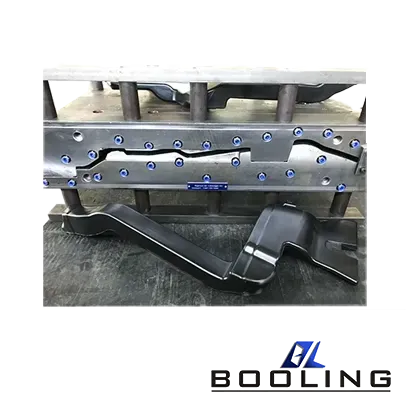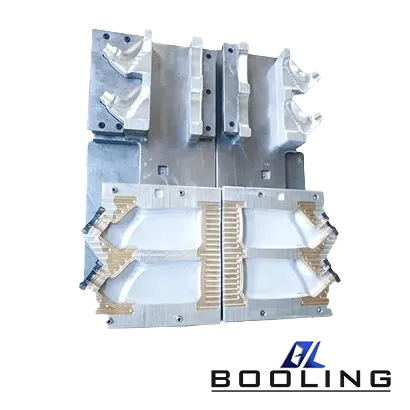Home > Stretch Blow Moulding
Plastic Blow Molding
Plastic blow molded products are very suitable for manufacturing products in homes and public places due to their high strength, easy cleaning, and long lifespan. The development of modern technology and continuous innovation of techniques will lead to a wider application of blow molding processing technology.

Stretch blow moulding is a process that uses compressed air to blow and expand the longitudinally stretched billet, and then horizontally stretch it to obtain a certain shape of the product. This blow molding process can effectively alter the physical properties of raw materials, such as hardness, rigidity, and impact resistance. Stretch blow moulding can be said to be a combination of extrusion plastic blow molding and injection blow molding, also known as the two-step method. Although it has a unique production method, it still has higher energy consumption and cost compared to the one-step method.

The Advantages of Stretch Blow Moulding
The stretch blow moulding process is also a common plastic product production process, which is widely used like extrusion molding and injection molding, with a wide variety of products that can be produced and outstanding advantages.
The Material has A Wide Range of Applications: stretch blow moulding is not only suitable for the processing of ordinary plastic materials but also for the processing of polypropylene (PP) and ethylene glycol acetate (PETP).
Physical Properties: Stretch blow moulding can improve the transparency, surface gloss, and impact strength of products, giving them superior hardness and rigidity, and longer service life.
Cost-effectiveness: The molds and machinery for stretch blow moulding are simple, with a lower cost budget and faster product output speed. At the same time, there is less plastic waste and faster recycling speed.
Product Diversification: Stretch blow moulding can manufacture various complex products to meet the needs of various customers. The production process of blow-molded products can produce containers of various styles and shapes. At the same time, blow-molded products can also add various forms such as different colors and textures. This makes the application range of blow-molded products more extensive.
Mass Production: Due to its high efficiency, stretch blow moulding can be used for large-scale production of a product, shortening the supply cycle.
Product Quality: The products produced by stretch blow moulding have high quality, uniform thickness, and less weight tolerance, making them suitable for the production of more precise products.

Selection of Stretch Blow Moulding Machine
The stretch blow moulding machine is a type of plastic processing machine, and multiple factors should also be considered when selecting the machine type.
- Performance of Blow Molding Machine
In stretch blow moulding, good production equipment can accelerate production speed and improve product quality. In current manufacturers, blow molding machines usually last for 24 hours, so the better the performance of the blow molding machine, the more stable the production can be.
- Production Demand
Before selecting a blow molding machine, it is necessary to first understand the parameters of the product that the customer wants to produce, and then choose a blow molding machine based on the production quantity and accuracy of the product. If the requirements are small, a highly cost-effective blow molding machine can be chosen.
- Brand Services
Before choosing a stretch blow moulding machine, it is advisable to compare prices and choose the merchant with the best service and machine quality. This is related to the subsequent installation and after-sales service of the blow molding machine.
- Mold Parameters
Before selecting a machine, it is necessary to first understand the type of mold used by the machine and choose a machine that is suitable for this mold to ensure smooth installation in the future.
- Cost
On the premise of ensuring the quality of the blow molding machine, try to reduce costs and improve cost-effectiveness, which also includes subsequent maintenance costs.
- Locking Force
Select the appropriate locking force based on the type of product and the selected material to ensure the stability of the blow molding machine during operation.
- Heating Method
The fastest possible heating method should be selected for uniform heating. The axial temperature of the billet can be set and monitored in advance to strictly control the heating effect.

The Application of Stretch Blow Moulding
After stretching and blow moulding, the impact strength, extreme weather resistance, transparency, surface roughness, stiffness, and barrier properties of the material have been significantly improved and enhanced, especially the increase in impact strength, expanding the application range of blow molded products and receiving favor from different industries.
Agricultural industry: Stretch blow moulding technology can manufacture agricultural water pipes, agricultural film covering, and other products. Due to its durability, it has made a huge contribution to water-saving irrigation and improved agricultural production efficiency.
Packaging Industry: Stretch-blown products are the most widely used in the packaging industry, such as the manufacturing of plastic bottles and containers. Their good transparency and lightweight durability can meet the packaging needs of different industries such as food, cosmetics, and medicine.
Plastic Products Filed: Blow molding technology is widely used in the plastic products industry, such as plastic pots and pans, plastic tables and chairs, plastic toys, etc. It has the characteristics of low cost, high aesthetics, and easy processing, and is deeply welcomed by consumers.
Medical Industry: In medical products, syringes, infusion bottles, and the outer packaging of medical devices are all produced through blow molding, and their non-toxic and harmless characteristics have taken a big step forward in the development of the medical field.
Toy Industry: Blow molding technology can manufacture complex plastic toys, satisfying children’s curiosity. Plastic has a variety of colors, is safe and durable, and is popular among consumers.
Electronics Filed: The plastic raw materials used in blow molded products have good electrical insulation performance, are lightweight, corrosion-resistant, and can be well used as shells for electronic products.
The Automotive Parts Industry: The production of automotive fuel tanks, water tanks, and other components involves blow molding processes, and their characteristics can also adapt well to the environment of automotive use.
Construction Industry: The pipes and plastic sheets produced by blow molding have the characteristics of corrosion resistance, which greatly extends the service life of houses.
Chemical: The application of stretch blow moulding in the chemical industry mainly includes paint barrels and fertilizer barrels, because they have good corrosion resistance and chemical resistance.
The Process of Stretch Blow Moulding
The stretch blow moulding process should fully consider the moulding process and product design, and its design points mainly include:
- Appropriate inflation ratio
- Surface quality of mold cavity and parting surface
- Design of clamping mouth
- Design of exhaust system
- The cooling system needs to cool quickly and evenly
- Selection of Mold Materials
The general process of stretch blow moulding is somewhat different from other blow molding processes.
- Mold and Product Design: Before starting the stretch blow moulding process, it is necessary to design the mold and product renderings (which can be designed through CAD software). This determines the blueprint for subsequent products, and once put into use and modified, the cost consumption is very high.
- Selection of Raw Materials: Common blow molding materials include polyethylene (PE), polyvinyl chloride (PVC), polypropylene (PP), and polystyrene (PS), which can become plastic particles in a molten state. If certain additives need to be added, they need to be proportioned according to the quantity and weight of the raw materials to avoid waste.
- Material Processing: Put the selected plastic raw materials from the previous step into the hopper and heat them with a heater until they melt. During this period, temperature and pressure should be well controlled to avoid reducing the plasticity of plastic materials.
- Mold Making: A mold is a production tool, and once the size of the mold is determined and put into use, it cannot be modified later, so this step is crucial. Molds are generally made of metal, such as cast iron, stainless steel, aluminum alloy, etc. Different raw materials have different characteristics, so the manufacturer should also consider the characteristics of the produced product when choosing.
- Stretch Blow Moulding: Once the plastic becomes molten, it is sent into a tubular plastic billet and then compressed into the mold by air. Through the joint action of the exhaust system and cooling system, the plastic parts quickly solidify and solidify.
- Cooling and Curing: Formed plastic parts need to be cooled and cured before demoulding to ensure that they do not shrink and increase the scrap rate. However, products that have not been completely cooled or cured can also undergo secondary processing after treatment, reducing waste of raw materials and improving cost-effectiveness.
- Post-de-molding Treatment: Although blow-molded products have very few burrs, it does not mean that they do not exist. The molded parts removed from the mold still need to be cut and repaired to obtain the final required product.
- Inspection and Testing: After the previous trimming is completed, the product needs to be compared with the parameters to prevent its quality and performance from not meeting the requirements. Its functionality should also be tested to prevent the production of defective parts.
- Packaging and Transportation: After the product is labeled and packaged, it can be counted to ensure that it is delivered to customers in sufficient quantity and quantity to prevent subsequent after-sales needs.
Related News
Applied’s expertise in modifying materials at atomic levels and on an ihdustrial scaleenables our customers to transform possibilities into reality.



